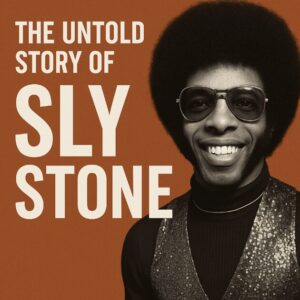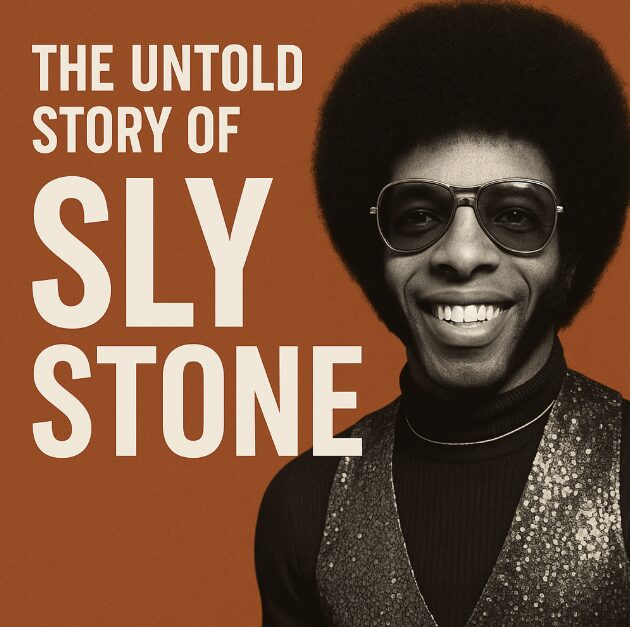When the world thinks of funk, soul, and psychedelic rock, one name inevitably rises to the top—Sly Stone. Known for being the mastermind behind Sly and the Family Stone, Sly didn’t just make music; he created a movement. He challenged racial and gender norms in the 60s and 70s, and brought a sound so unique that it still influences generations of artists today—from Prince and Lenny Kravitz to Kendrick Lamar and Bruno Mars.
But who exactly was Sly Stone? Beyond the shimmering vests and wild hair, beyond the legendary basslines and crowd-shaking anthems, there was a man with a story—complicated, fascinating, and tragically human.
Let’s dive into his music, personal life, children, relationships, and the band members who helped define an era.

Who Was Sly Stone?
Born Sylvester Stewart on March 15, 1943, in Denton, Texas, Sly grew up in a religious household and started his music journey in the church. By the time he moved to the Bay Area in California, he was already a musical prodigy—playing multiple instruments and producing records before the age of 25.
In the mid-60s, he formed Sly and the Family Stone, one of the first racially and gender-integrated bands in mainstream American music history. Their style blended funk, soul, rock, and psychedelia—a genre-defying fusion that mirrored the social revolutions of the time.
Signature Songs That Changed Music History
Sly’s discography is packed with era-defining anthems. If you’re just discovering his work, start with these essentials:
“Dance to the Music” (1968)
A literal call to action. This track didn’t just introduce funk to the mainstream—it commanded it.“Everyday People” (1969)
A soulful plea for equality. The lyric “Different strokes for different folks” entered pop culture forever.“Thank You (Falettinme Be Mice Elf Agin)” (1969)
Basslines that inspired generations, lyrics that spoke of rebellion and freedom.“Family Affair” (1971)
A slower, darker, more introspective Sly. This hit stayed at #1 on the Billboard Hot 100 for three weeks.“If You Want Me to Stay” (1973)
Funky, romantic, unpredictable—like Sly himself.
Each song is a chapter of his life, echoing his joy, his chaos, and his brilliance. Spotify or YouTube them today and you’ll still hear how fresh they sound. His basslines—especially those played by Larry Graham—rewrote the rules for funk forever.
Children and Private Life
Sly Stone was notoriously private about his family, but we do know he had several children, at least four, from different relationships. One of his daughters, Novena Carmel, has followed in his musical footsteps and is now a radio host on KCRW in Los Angeles.
In interviews, Novena has spoken with both admiration and candidness about her father’s legacy, describing him as “an artistic genius and a human being who struggled.”
Sly’s complicated relationship with fame, drugs, and the pressures of being a cultural icon made his family life challenging. At one point in the 2010s, he was reportedly living in a van in Los Angeles. Yet, through it all, his children and loved ones never spoke ill of him publicly. It seems they understood the duality of genius and struggle.
Was He Married? His Romantic Life
Sly Stone was once married to Kathy Silva, an actress and model. Their wedding was far from ordinary—it took place in 1974 at Madison Square Garden, on stage, in front of over 20,000 people during a concert.
The spectacle was meant to be a celebration of love and funk, but the marriage didn’t last long. The couple had a son, Sly Jr., but were divorced within a year.
Sly’s relationships were often turbulent. His struggles with substance abuse and paranoia reportedly caused deep rifts. But it’s also clear that he was intensely charismatic, unpredictable, and magnetic—qualities that drew people to him again and again, despite the chaos.
The Band That Changed Everything
Sly and the Family Stone was more than a backing band—it was a cultural revolution in motion.
Here are some of the key members:
Larry Graham (bass)
Invented “slap bass” technique. Later formed Graham Central Station and worked with Prince.Cynthia Robinson (trumpet)
One of the first female trumpeters in a major band. Her voice shouts “All the squares, go home!” in “Dance to the Music.”Freddie Stone (guitar)
Sly’s brother. Solid, funky, and often the band’s stabilizing force.Rose Stone (keyboard, vocals)
Sly’s sister. Her voice on “You Can Make It If You Try” gave hope to a generation.Greg Errico (drums)
A master percussionist who would later work with Weather Report and David Bowie.Jerry Martini (saxophone)
Brought the jazz and rock elements into the band’s DNA.
This group was intentionally inclusive, not just musically but socially. At a time when the U.S. was tearing apart over race and gender, Sly was putting together a band that looked like the future—Black, white, male, female, together as one.
Why He Disappeared from the Spotlight
By the mid-70s, Sly Stone’s life was unraveling. Despite his commercial success, he struggled with addiction, paranoia, and the pressure of being a cultural symbol.
He became increasingly unreliable—missing shows, abandoning sessions, and distancing himself from collaborators. By the 1980s, he had all but vanished from public view.
Occasional attempts at a comeback occurred (a Grammy appearance in 2006, his 2011 solo album I’m Back! Family & Friends), but he never returned to the center stage that once belonged to him. Legal battles over royalties also haunted his later years.
Still, Sly Stone never fully faded away. His influence could be heard in almost every major artist that came after—from the gritty funk of George Clinton to the pop soul of Justin Timberlake.
A Final Goodbye: Sly Stone’s Passing in 2025
On June 9, 2025, Sly Stone passed away at the age of 82. The cause of death was complications related to COPD (chronic obstructive pulmonary disease). He died in Los Angeles, surrounded by family.
Tributes poured in from artists around the world. Questlove called him “the blueprint.” Lenny Kravitz posted a black-and-white photo with the caption: “You changed the world. Thank you, Sly.”
His death marked the end of an era, but also the start of a renewed appreciation. Vinyl reissues sold out. His memoir climbed back up the bestseller charts. Young listeners discovered his music for the first time and said what others have said for decades: “This still sounds like the future.”
Where to Explore More of His Legacy
If this post sparked your curiosity, here’s where to go next:
Listen to Sly and the Family Stone Essentials on Apple Music or Spotify
Watch the documentary Summer of Soul for a glimpse of Sly at his peak
Read his 2023 memoir “Thank You (Falettinme Be Mice Elf Agin)” for a raw look into his inner world
Dive into reaction videos on YouTube where Gen Z discovers “Everyday People” or “Family Affair” for the first time
There’s something magical about watching new generations fall in love with what Sly created.
What Sly Stone Taught Us About Being Human
Sly Stone wasn’t perfect. He was messy, brilliant, loving, difficult, generous, and mysterious—all at once. His story is one of creative genius clashing with the realities of fame and addiction. But through the noise, one message always came through: unity.
He made us dance. He made us think. He made us feel.
In the words of his own song:
“It’s a family affair.”
And somehow, even now, we’re still part of that family.
